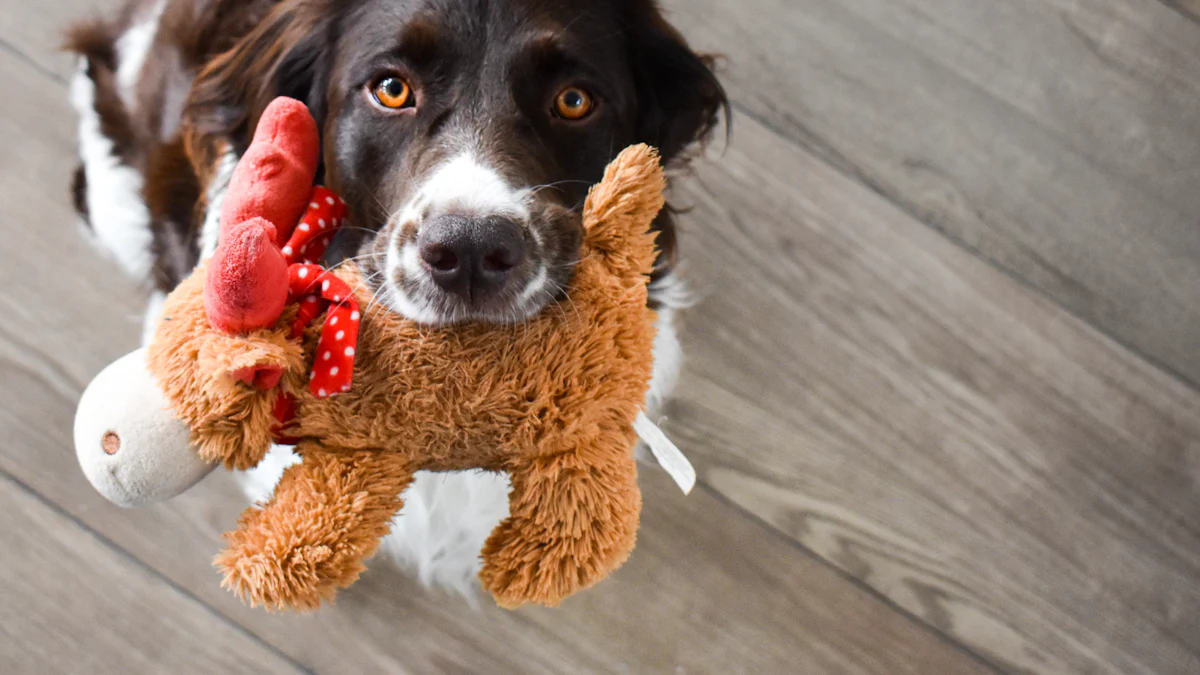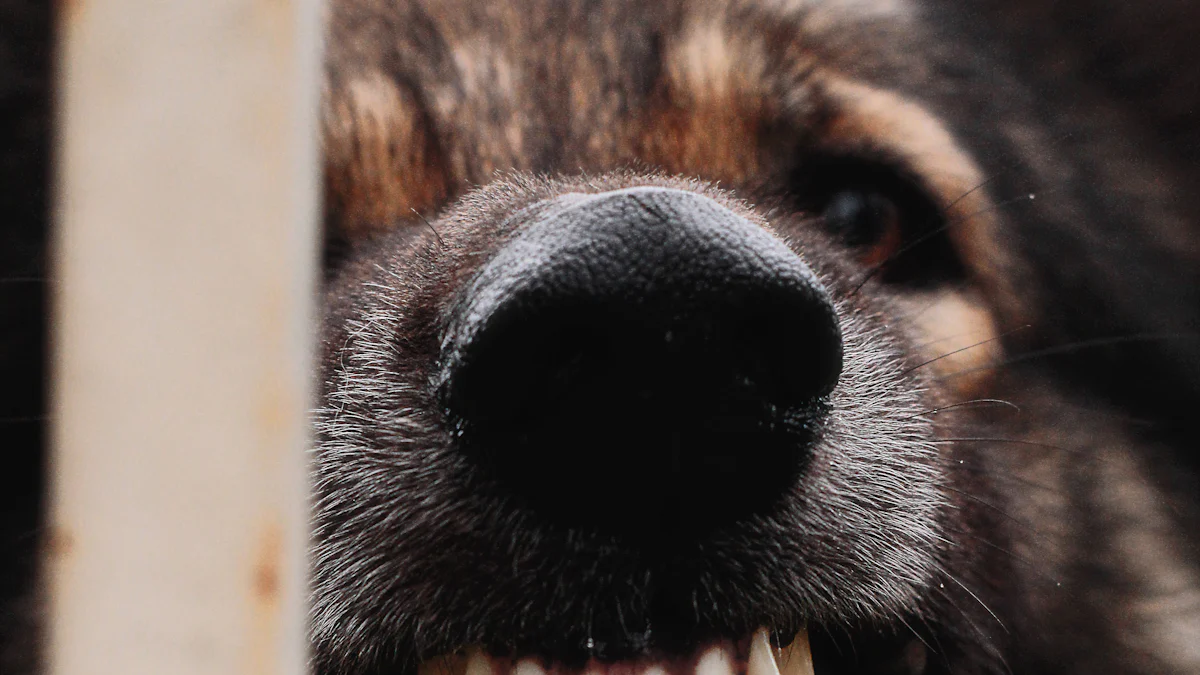
Welcome to the intriguing world of canine behavior! Understanding why Dogs exhibit certain actions, like dog whines while chewing toy, is key to strengthening your bond with your furry companion. By delving into the reasons behind this behavior, you can decode their unique way of communication and ensure their well-being. Let’s explore the fascinating realm of Dog Chew Toys and unravel the mysteries behind why your pet may vocalize while enjoying playtime.
Why Dogs Whine
Common Reasons
Understanding Whining
When your dog starts to whine, it’s essential to pay attention as it could be their way of expressing various needs or emotions. Research has shown that whimpering is a common form of communication for dogs, indicating distress or pain. By understanding this behavior, you can better respond to your furry friend’s requirements and ensure their well-being.
Importance of Observing Behavior
As responsible dog owners, observing and interpreting your pet’s actions is crucial in maintaining a healthy relationship. Dogs use vocalizations like whining to seek attention, express excitement, anxiety, or even communicate with humans. By closely monitoring their behavior while they engage with dog toys, you can gain valuable insights into their emotional state and address any underlying issues promptly.
dog whines while chewing toy
Identifying the Issue
If your dog is whining while chewing a toy, it might indicate a range of feelings or discomfort they are experiencing. Dogs may vocalize when they feel anxious, stressed, possessive of the toy, or even if they are seeking attention. It’s important to observe other cues along with the whining to pinpoint the exact cause behind this behavior.
Responding to Whining
When your furry companion whines during playtime with a toy, consider creating a calm and safe environment for them to enjoy their chew session without interruptions. Providing alternative toys or engaging in interactive play can help alleviate any stress or anxiety they might be feeling. Remember, responding positively and attentively to their needs can strengthen your bond and create a harmonious interaction between you and your beloved pet.
Dental Pain

Teething in Puppies
Pet Dental Health Case Studies
- Symptoms of Teething: Puppies experiencing the teething phase may display signs such as increased chewing behavior, swollen gums, and occasional whining. These symptoms are natural as their baby teeth make way for the stronger adult ones.
- How to Help: Providing appropriate dog chew toys designed for teething can offer relief to your puppy’s sore gums. Additionally, freezing a wet washcloth or offering frozen treats can help soothe discomfort during this developmental stage.
Adult Dogs
Dental Disease and Oral Pain – Case Study #1
- Signs of Dental Issues: Adult dogs with dental problems may exhibit symptoms like bad breath, reluctance to eat hard food, pawing at the mouth, or excessive drooling. These signs indicate potential oral pain that requires attention.
- When to See a Vet: If you notice persistent signs of dental issues in your dog, it’s crucial to consult a veterinarian promptly. Delaying treatment can worsen the condition and lead to further discomfort for your furry companion.
Anxiety and Stress
Causes of Anxiety
Environmental Factors
When your dog is in an unfamiliar environment, it can feel anxious and stressed. New places, loud noises, or crowded spaces may trigger these emotions in your furry friend. To help them cope with such situations, consider introducing them gradually to new environments and providing reassurance through your presence.
Changes in Routine
Any sudden changes in your dog’s daily routine can lead to feelings of anxiety. Dogs thrive on predictability and structure, so unexpected alterations can disrupt their sense of security. To ease their anxiety during such times, try to maintain a consistent schedule for feeding, walks, and playtime. This stability can help them adapt more comfortably to any modifications.
Managing Stress
Creating a Safe Space
Every dog needs a place where they can retreat and relax when feeling overwhelmed. Designate a cozy corner or a comfortable bed as their safe space, ensuring it’s quiet and free from distractions. By providing this sanctuary, you offer your pet a calming environment where they can unwind and de-stress whenever needed.
Using Calming Toys
Introducing calming toys into your dog’s playtime routine can significantly reduce their stress levels. Certain toys are designed to provide mental stimulation and relaxation, helping your pet channel their energy positively. Look for interactive puzzles or chew toys that promote focus and engagement while soothing any anxious feelings they may have.
Instinctive Behavior
Natural Instincts
Prey Drive
Dogs possess a remarkable instinct known as prey drive. This innate behavior stems from their ancestry as hunters and is characterized by a strong desire to chase, catch, and play with objects that mimic prey. When your furry friend engages in play with dog chew toys, their prey drive may be triggered, leading to enthusiastic interactions as they satisfy this primal urge.
Self-Soothing
Another fascinating aspect of dogs’ instinctive behavior is their ability to self-soothe through activities like chewing on toys. This self-comforting behavior is a natural response that helps them relax, reduce stress, and maintain emotional balance. By providing appropriate chew toys, you enable your pet to engage in self-soothing activities that promote mental well-being and contentment.
Plays With Squeaky Toys
Reaction to Sounds
The allure of squeaky toys for dogs lies in the intriguing sounds they produce. The high-pitched squeaks mimic the noises of small animals or birds, triggering your pet’s curiosity and excitement. When your furry companion encounters a squeaky toy, their immediate reaction may include heightened interest, playful behavior, and an eagerness to explore the source of the enticing sound.
Providing Alternatives
While squeaky toys can be entertaining for dogs, it’s essential to offer a variety of toy options to cater to different preferences. Introducing interactive puzzles, durable chew toys, or engaging fetch toys alongside squeaky dog toys can enrich your pet’s playtime experience and stimulate their cognitive abilities. By rotating between various toy types, you keep playtime engaging and prevent boredom while encouraging physical activity and mental stimulation.
Attention Seeking
When Dogs exhibit attention-seeking behavior, it’s their way of communicating a desire for interaction and engagement with their human companions. Recognizing these signals is essential in fostering a strong bond and meeting your pet’s emotional needs effectively.
Recognizing Attention-Seeking Behavior
- Pawing: Your furry friend may gently paw at you or the surrounding area to grab your attention.
- Whining: Vocalizing with soft whimpers or high-pitched sounds can indicate a plea for interaction.
- Eye Contact: Maintaining steady eye contact or gazing at you attentively is another sign of seeking attention.
In response to these cues, engaging with your dog through play, petting, or verbal praise can reinforce positive behavior and strengthen your connection.
Training Tips
Positive Reinforcement
- Offer treats or verbal praise when your dog displays desired behaviors like sitting calmly or waiting patiently.
- Use a clicker to associate the sound with rewards, encouraging positive actions during training sessions.
- Incorporate short training sessions throughout the day to maintain consistency and reinforce good conduct.
By rewarding positive actions promptly and consistently, you encourage your furry companion to seek attention through desirable behaviors.
Consistency in Training
- Establish clear rules and boundaries to provide structure for your dog‘s interactions and activities.
- Use consistent commands and gestures during training sessions to avoid confusion and promote understanding.
- Practice patience and persistence when teaching new behaviors, allowing time for your pet to learn and adapt.
Maintaining consistency in training methods helps create a harmonious environment where your dog feels secure and understands what is expected of them.
Possessiveness
Attachment to Toys
When dogs show signs of possessiveness towards their favorite toys, it’s essential to understand the underlying reasons behind this behavior. Signs of possessiveness may include guarding the toy, growling when approached, or displaying tense body language. By recognizing these cues early on, you can take proactive steps to manage and address any potential issues that may arise.
Signs of Possessiveness
- Guarding Behavior: Your furry friend may exhibit possessive tendencies by guarding their toy and showing reluctance to share or let others come near.
- Aggressive Posture: Dogs displaying possessiveness might adopt an aggressive posture, such as stiffening their body, baring teeth, or growling as a warning signal.
- Intense Focus: When a dog becomes overly fixated on a particular toy and shows signs of distress when separated from it, it could indicate possessive behavior.
Understanding these signs can help you intervene effectively and prevent possessiveness from escalating into more concerning behaviors.
Managing Possessive Behavior
To address possessive behavior in dogs, consider implementing positive training methods that promote healthy interactions with toys and encourage sharing. Here are some tips to help manage possessiveness:
- Rotate Toys: Introduce a variety of toys in your pet’s playtime routine to reduce fixation on a single item and promote adaptability.
- Training Exercises: Engage in training exercises that focus on teaching your furry companion impulse control and proper toy-sharing etiquette.
- Positive Reinforcement: Reward desirable behaviors like sharing or relinquishing toys voluntarily with treats or praise to reinforce positive conduct.
By actively addressing possessive tendencies through training and positive reinforcement, you can create a harmonious environment where your pet feels secure and learns to enjoy playtime without feelings of anxiety or competition.
Dog Cries When Carrying
When your beloved dog cries while carrying a toy around, it can be an endearing yet intriguing behavior that warrants attention. Understanding the motivations behind this action is key to ensuring your pet’s emotional well-being and strengthening your bond through meaningful interactions.
Understanding the Behavior
The act of crying while carrying a toy may stem from various emotions or instincts within your furry companion. It could signify feelings of joy, excitement, attachment to the toy, or even mimicry of nurturing behaviors observed in the past. By observing their body language and vocalizations during this activity, you can decipher the underlying message they are trying to convey.
Solutions and Tips
To support your dog when they cry while carrying a toy, consider implementing the following strategies:
- Encouragement: Offer verbal praise or gentle pets when you notice them engaging in this behavior as a form of positive reinforcement.
- Interactive Play: Engage in interactive play sessions that involve their favorite toys to strengthen the bond between you and provide enriching experiences for your pet.
- Comfort Items: Provide additional comfort items like blankets or familiar scents near their resting area to enhance feelings of security during moments of carrying toys.
By responding attentively and positively to your pet’s actions while carrying toys, you create an environment filled with love, understanding, and mutual respect that nurtures a strong connection between you both.
In wrapping up our exploration of dog behavior while engaging with chew toys, it’s crucial to stay attentive and responsive to your furry friend’s needs. By recognizing early signs and seeking professional guidance when necessary, you can create a harmonious environment that fosters positive interactions. Remember, addressing behavioral issues with patience and understanding is key to strengthening your bond and ensuring a fulfilling life for your beloved companion. Embrace the journey of understanding your dog’s instincts and behaviors, and watch as your relationship flourishes through shared experiences and mutual respect.
Post time: Jun-13-2024